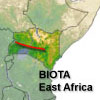 



Weather data
A large number of automatic weather stations has been implemented in the frame of the BIOTA AFRICA project by the Namibian National Botanical Research Institute (NBRI) and the Group "Biodiversity, Evolution and Ecology" (BEE) of the University of Hamburg. The website offers hourly updates of data and graphs of a large number of weather parameters.

|
 BIOTA East Africa - Cross-cutting themes
BIOTA East Africa - Cross-cutting themes
| CCT - Theme 4 |
Recommendations and measures for sustainable use of biodiversity |
| CCT Description |
Measures for sustainable use include the implementation of management plans for an existing tree nursery, implementation of planting strategies of indigenous trees on farmlands and enrich planting. The use of medicinal plants and of timber trees requires ex-situ conservation of endangered forest plants in Maseno Botanical Garden. Sites for seed collections to maintain genetic potential of tree species will be identified.
A simulation and prediction tool to model rain forest regeneration potential via seed dispersal processes between forest fragments will be prepared. In connection with GIS tools and time series as well as evaluation of socio-economic components, area-specific differences and political priorities, we intend to modify developed management plans according to the area-specific requirements and run equivalent test procedures.
Based on a multi-criteria analysis it is intended to describe how the interests of various stakeholders can be reconciled for sustainable use of forest biodiversity, how local communities' capacity can be enhanced to understand the economic value of forest resources and how in-built incentives for sustainable management can be created. Replicable participatory methods in protection and management of biodiversity will be developed involving communities around protected areas.
National and regional management authorities and stakeholders will take part in joint planning of respective actions and their implementation. The process will be accompanied by monitoring of the effectiveness of selected applications and the subsequent interchange of feedback information between stakeholders, local communities, management authorities and biodiversity researchers. |
| E01 - Conservation and sustainable use of East African rain forest ecosystems |
| Details |
WP2 |
Recommendations for participatory forest management planning |
| E02 - GIS and Remote Sensing in Support of Biodiversity Management at the Landscape Scale for Rainforests in Eastern Africa |
| Details |
WP2 |
Spatial extrapolation of BIOTA-East findings on biodiversity and ecosystem function predominantly over Kakamega Forest, plus interdisciplinary analyses considering spatial information |
| Details |
WP3 |
Identifying structural parameters and modelling socio-economic scenarios for the farmland surrounding Kakamega Forest as well as deriving a detailed up-to-date vegetation map for Kaka-mega Forest as a contribution to forest management |
| Details |
WP4 |
Applying spatial information in participatory forest management and landuse planning for Kakamega Forest and surroundings |
| E03 - Regeneration of tropical trees - implications for forest conservation |
| Details |
WP1 |
Experiments on germination and seedling establishment and application in the KEEP Tree Nursery |
| Details |
WP3 |
Experimental restoration and rehabilitation of degraded forest sites and threatened tree species |
| Details |
WP4 |
Modelling of tree stand and forest growth |
| E04 - Flora and vegetation of rainforests in East Africa - conservation and sustainable use |
| Details |
WP1 |
GIS-based vegetation mapping of Kakamega and Budongo Forest - Monitoring and assessment of biodiversity |
| Details |
WP2 |
Distribution and abundance of plant species originating from Kakamega Forest in farms and agricultural landscape elements |
| Details |
WP4 |
Ex-situ conservation of forest plants in Maseno Botanical Garden |
| Details |
WP7 |
Economic, ecological and agronomic evaluation of the on-farm cultivation of valuable forest species |
| E10 - Towards conservation and sustainable use of pollinators |
| Details |
WP1 |
Measures of pollinator conservation and long-term monitoring of bees |
| Details |
WP4 |
The potential of stingless bees and solitary bees as manageable crop pollinators |
| Details |
WP5 |
Raising public awareness to mainstream pollination into policy decisions and strategies |
| E11 - Human impact on avian diversity, seed dispersal and regeneration processes of East African rainforests: management tools and recommendations |
| Details |
WP1 |
Ficus-diversity as indicator for biodiversity and ecosystem functioning at different spatial scales |
| Details |
WP2 |
Management for high genetic diversity in Prunus africana: seed dispersers vs. pollinators |
| Details |
WP3 |
Multi-disciplinary analysis of data on biodiversity and ecosystem functions |
| Details |
WP4 |
Tropical farmland linking socio-economy, land use and bird diversity |
| E13 - Conservation and Management of Biodiversity for Rural Livelihoods: Developing Sustainable Strategies for Reconciling Stakeholders' Interests in Kakamega Forest |
| Details |
WP1 |
Development of collaborative or multi-stakeholder management strategies |
| Details |
WP4 |
Model-based scenario analysis of agricultural options to increase on-farm biodiversity |
| E14b - Sustainable use and management of biodiversity for rural livelihood |
| Details |
WP1 |
Development of instruments to reconcile biodiversity with changing human needs |
| E16 - Ant and termite communities along a habitat degradation gradient: patterns and consequences for ecosystem function |
| Details |
WP2 |
Diversity and abundance of ants and termites along a habitat degradation gradient |
| Details |
WP3 |
Trophic ecology of ants and termites |
| Details |
WP4 |
Ant predation and herbivore-control: from rainforest to intensively used farmland |
| Details |
WP5 |
Use of farmland habitat, temperature tolerance and the survival of ant species in forest fragments |
| Details |
WP6 |
Effects of termite diversity on decomposition rates |
|
|






 Go to the WeatherNet
Go to the WeatherNet BIOTA East Africa - Cross-cutting themes
BIOTA East Africa - Cross-cutting themes